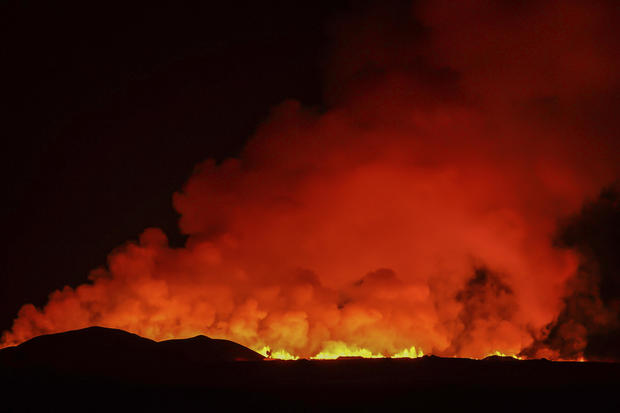A volcano in southwestern Iceland erupted Thursday, less than two months after a previous eruption in the area forced the evacuation of the coastal town of Grindavik.
The eruption began about 6 a.m. local time, sending lava into the air along a 1.9-mile-long fissure northeast of Mount Sundhnukur, the Icelandic Meteorological Office said.
Agence France-Presse says live video showed the glowing lava lighting up a plume of smoke rising from it.
Coast Guard surveillance indicated the eruption was taking place in the same area as one that occurred Dec. 18. The Met Office said lava was flowing to the west and there was no immediate threat to the town of Grindavik — evacuated after a previous eruption — or to a major power plant in the area.
Icelandic national broadcaster RUV said the nearby Blue Lagoon thermal spa, one of Iceland’s biggest tourist attractions, was closed when the eruption began and guests were evacuated to hotels.
This is the third eruption since December of a volcanic system on the Reykjanes Peninsula, which is home to Keflavik, Iceland’s main airport. There was no disruption reported to the airport on Thursday.
Grindavik, a town of 3,800 people about 30 miles southwest of Iceland’s capital, Reykjavik, was evacuated in November when the Svartsengi volcanic system awakened after almost 800 years with a series of earthquakes that opened large cracks in the earth between the town and Sýlingarfell, a small mountain to the north.
The volcano eventually erupted on Dec. 18, sending lava flowing away from Grindavik. A second eruption that began on Jan. 14 sent lava towards the town. Defensive walls that had been bolstered since the first eruption stopped some of the flow, but several buildings were consumed by the semi-molten flow.
Iceland, which sits above a volcanic hot spot in the North Atlantic, averages an eruption every four to five years. The most disruptive in recent times was the 2010 eruption of the Eyjafjallajokull volcano, which spewed huge clouds of ash into the atmosphere and led to widespread airspace closures over Europe.
The Reuters news service notes that Iceland, which is about the same size as Kentucky, has more than 30 active volcanoes, a big lure for tourists.



